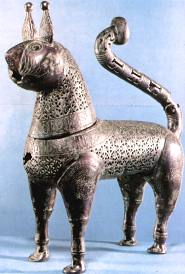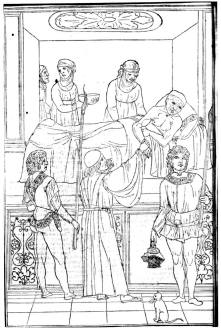

Most Western artists of the Middle Ages produced religious paintings. Each object in a painting symbolized a particular idea or concept in Christian doctrine. In the iconography of Christian art, the cat symbolized both laziness and lust. The Middle Ages were dark centuries for the cat in the Christian world, where it was widely believed that the devil took the form of a black cat. Persecution, torture and death became the likely fate of humans who showed attention or affection to any cat. | |
 |
In the Islamic world, the cat was respected and protected because cats were loved by the prophet Mohammed, the founder of Islam. There is a story that Mohammed's cat Muezza once fell asleep on the sleeve of his master's robe --instead of disturbing his beloved cat when he had to leave, Mohammed cut off the sleeve of his robe. This bronze incense burner represents a cat with its mouth half open and ears pricked. The back, neck and chest are all perforated to allow incense to escape. On the cat's chest is an inscription in the Kufic script which says: "Valor, power, and glory." [c. 11th or 12th century, bronze incense burner, Islamic, Seljuk] |
| |||
|
 | ||
 |
Cats were honored and
protected in Asia because the humans there recognized the value of our
services in protecting food crops and the silk worm industry from
destruction by rodents. This cat appeared in a 1494 album of studies by
the Chinese painter Shên Chou, one of the first great masters of the Ming
Dynasty.
Although created in the same year as the woodcut above, the painting seems modern in the way it allows us a glimpse of the cat's personality. [1494, Shên Chou, Cat (detail), painting] |
 | ||
| ||
| ||
| ||